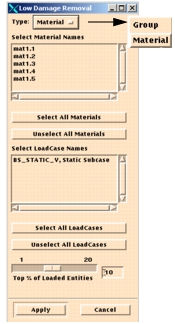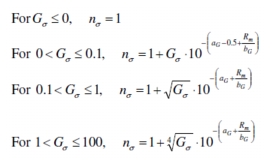XXXXXXXXXXXXXXXXXXXXXXXXXXXXXXXXXXXXXXXXXXXXXXXXXXXXXXXXXXXXXXXXXXXXXXXXXXXXXXXXXXXXXXXXXXXXXXXXXXXXXXXXXXXXXXXXXXXXXXXXXXXXXXXXXXXXXXXXXXXXXXXXXXXXXXXX''"> Fatigue Preprocessing
MSC.Fatigue has the following preprocessing modules:
1. Set Fatigue Enviromental Variables
2. Low Damage Removal
3. Calculate Stress Gradient
Low Damage Removal

The Low Damage Removal utility is designed to extract areas of the model that are likely to sustain high damage. These areas are then grouped based on user selection of existing user created groups or automatically extracted material groups resident in the Patran database. In the example shown on the right the user may select all or pick one or more of the automatically extracted material groups. The Von mises stress or strain results from all selected loadcases are scanned and for each material group, a group is created that contains the top user-selectable percentage of loaded entities in that group. The solution sequences that utilize stress or strain results can benefit from this extraction. The only exception to this is Seam weld and although this utility can be used to identify the critical areas, users will have to exercise caution in using the extracted groups as the Seam weld module performs an extraction of the seam off the weld group and it is possible that the weld may not be a part of the extracted group.
For the force based Spotweld solution sequence critical Spot weld elements are extracted based on the magnitudes of the translational and rotational components. Either the material group associated with the Spot weld elements or a group containing only the Spot weld elements (recommended) is used for the extraction.
The groups extracted by this utility may then be used in a subsequent fatigue analysis for a quick assessment of the high damage areas of the model.
Note: | This extraction performed by this Utility does not take into account the phasing from Superpositioning of the results for multiple channel loading. FASTAN should be used in this case as proper account of the phasing is taken into account to extract high damage areas. |
This Low Damage Removal utility can be accessed by selecting the option from the Fatigue Preprocessing pulldown menu under Tools | MSC.Fatigue (for Patran) or under Tools | Fatigue Utilities (for Pre & Post).
From the low damage removal form:
1. Select the Type (either Group or Material).
2. Select either the material names or group names that are of interest.
3. Select the loadcases.
4. Select the percentage of loaded entities desired. The default value is 10 but you can select a value anywhere from 1 to 20. (i.e., If you select 15 then the top 15 percent of damaged entities will be added to the new group)
5. Hit Apply. The results data for each selected material name or group name is processed and the top requested percent of elements with the worst damage are put into a group using the following naming convention: HD_material name or HD_group name. (ie. If you selected mat1.1 and mat1.2 then two new groups would be created. One called HD_mat1.1 and the other called HD_mat1.2)
6. These new groups can then be used in the Materials Information form to quickly identify the “Fatigue hot-spots” in the Model.
Calculate Stress Gradients
If fatigue calculations are made based on either local elastic stresses calculated from FE, or based on nominal stresses and Kt values, over conservative life predictions may result. This is particularly a problem with many engine and powertrain components where combinations of sharp stress concentrations, small fillet radii and notch-insensitive cast materials can lead to the effect being quite large. The stress gradient correction adopted in MSC.Fatigue is based on a method described in the FKM Guideline "Analytical Strength Assessment of Components in Mechanical Engineering" 5th edition, 2003, English version, Tr. E. Haibach published by VDMA, Frankfurt. ISBN 3-8163-0425-7. This method which considers only normal and shear cases, and positive stress gradients, is an endurance limit approach. It does not allow corrections at shorter lifetimes or specify how it might be applied to a general multiaxial case.
In MSC.Fatigue we are effectively applying the same factor to the strength at all lifetimes. This means predictions at shorter lifetimes may still be somewhat conservative, but not as conservative as predictions made with no stress gradient correction.With the application targeted for such components, the stress gradient correction has only been implemented for solid element FE models and users should not use this for shell element models.
The FKM method considers only normal and shear cases, and does not allow for more complex loadings, or for cases where the stress gradient may be negative. In the absence of better information, the FKM method in MSC.Fatigue has been adapted by considering only the normal stress gradient and making some reasonable assumptions with recognition to the fact that the stress gradient is a second-order effect on fatigue life.
In general we have 6 (3D) or 3(2D) stress gradients, which can all vary with time and in relation to one another. We have to define some way of determining a single stress gradient, which can be used to determine the appropriate correction factor. Possibilities are:
1. Determine a separate stress gradient for each component for each moment in time and correct each component independently.
2. Determine the gradient of stress corresponding to the damage parameter being used, so if the damage parameter is abs-max-principal, we also determine the gradient of abs-max-principal stress.
3. Be more consistent and use the gradient of the von Mises stress. Since von Mises strain is proportional to von Mises stress, we could use this method equally well with stresses or strains.
There are arguments for and against all three options. MSC.Fatigue uses option 3, defining the normalized stress grdient G
σ as:

The correction factors n
σ are calculated using the FKM guidelines as follows:

The dimensions are in mm, and the stress gradients in mm-1. Rm is the UTS in MPa. The required constants are material dependent, and come from the following table:
The correction factor n is calculated on a point-by-point basis, and the stress or strain history is then corrected as:

The Calculate Stress Gradient utility can be accessed by selecting the option from the Fatigue Preprocessing pulldown menu under Tools | MSC.Fatigue (for Patran) or under Tools | Fatigue Utilities (for Pre & Post).
 The Low Damage Removal utility is designed to extract areas of the model that are likely to sustain high damage. These areas are then grouped based on user selection of existing user created groups or automatically extracted material groups resident in the Patran database. In the example shown on the right the user may select all or pick one or more of the automatically extracted material groups. The Von mises stress or strain results from all selected loadcases are scanned and for each material group, a group is created that contains the top user-selectable percentage of loaded entities in that group. The solution sequences that utilize stress or strain results can benefit from this extraction. The only exception to this is Seam weld and although this utility can be used to identify the critical areas, users will have to exercise caution in using the extracted groups as the Seam weld module performs an extraction of the seam off the weld group and it is possible that the weld may not be a part of the extracted group.
The Low Damage Removal utility is designed to extract areas of the model that are likely to sustain high damage. These areas are then grouped based on user selection of existing user created groups or automatically extracted material groups resident in the Patran database. In the example shown on the right the user may select all or pick one or more of the automatically extracted material groups. The Von mises stress or strain results from all selected loadcases are scanned and for each material group, a group is created that contains the top user-selectable percentage of loaded entities in that group. The solution sequences that utilize stress or strain results can benefit from this extraction. The only exception to this is Seam weld and although this utility can be used to identify the critical areas, users will have to exercise caution in using the extracted groups as the Seam weld module performs an extraction of the seam off the weld group and it is possible that the weld may not be a part of the extracted group. 


